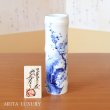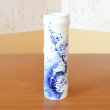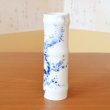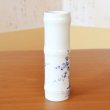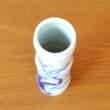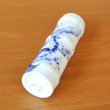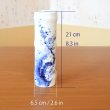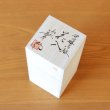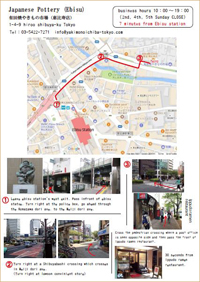Bamboo-Shaped Vase Sometsuke Ume Plum Blossom Painting | The first-generation head of the Shinemon Kiln [146184]
Price: 110,000JPY
Weight: 2000g
Item description
Width: 6.5cm / Height: 21cm
Width: 2.6in / Height: 8.3in
-----------------------
This piece was created by the late Shinichiro Baba, the first-generation master of the Shinemon Kiln?one of the most renowned kilns representing Arita ware. The vase, shaped like a bamboo tube, features a bold depiction of plum blossoms painted in *sometsuke* (underglaze blue). Crafted with Arita ware’s refined techniques, this bamboo-inspired vessel embodies the essence of Japanese aesthetics: tranquility, dignity, and *wabi-sabi*.
Today, the Shinemon Kiln is best known for its expertise in *y?hen*?a highly regarded glazing technique that creates brilliant, unpredictable color changes. However, this particular work does not use *y?hen*, but instead is rendered in *sometsuke*. That’s because it was created by the founding master, Shinichiro Baba himself, early in his career. The use of *sometsuke*, one of Arita’s most traditional painting techniques, showcases his mastery in brushwork and design. As the current Shinemon Kiln rarely produces pieces in *sometsuke*, this vase is now a rare and highly valuable work.
Its unique form, inspired by a bamboo cylinder, makes it ideal for use as a single-flower vase (*ichirin-zashi*). The elegant shape, faithfully capturing the presence of bamboo through Arita craftsmanship, adds a dignified touch to any Japanese-style interior. When a single flower is placed in the vase, it creates a serene harmony between the vessel and nature, allowing the viewer to appreciate the beauty of negative space.
The motif depicted in the painting is the “plum blossom,” a symbol of hope and new beginnings, as it blooms even in the cold of winter. Traditionally considered an auspicious design, the plum blossom also represents longevity, prosperity, and nobility. Its delicate yet resilient form resonates with the Japanese aesthetic and evokes a deep sense of *wabi-sabi*.
From a technical perspective, this piece uses the *sometsuke* method, in which designs are painted directly onto the bisque-fired surface before glazing. The brushwork and fluidity of ink?characteristic of *sometsuke*?create a subtle landscape-like expression. Because the porous surface absorbs the pigment immediately, any error is irreversible, making this a one-shot technique that requires extreme precision, patience, and compositional skill. This vase is a true testament to craftsmanship at its finest.
[Potter Profile]
Shinichiro Baba (deceased)
The first-generation head of the Shinemon Kiln
Member of Nitten / Full Member of the Japan Contemporary Arts and Crafts Association / Member of the Saga Prefecture Ceramic Association / Member of the Arita Ceramic Association
[Shinichiro Baba's career is as follows ]
Born in 1924 in Arita, Saga Prefecture
1972: Founded the Shinemon Kiln in Arita.
1979: Selected for the Prefecture Exhibition with "Hexagonal Celadon Bowl."
1981: Selected for the Nitten exhibition with "Oil Spot Tenmoku Large Bowl," subsequently selected 21 times.
1989: Appointed as an art exhibition judge.
2000: Exhibited "Saiun-99" and "Sai-99" at the British Museum in London (Saga Prefecture Ceramic Exhibition).
2004: Exhibited "Saikei" and "Saimon" at the Arita Pottery Exhibition in Germany.
[Main Awards]
1983: Won the First Place Bijutsu Kyokai Prize at the Bijutsu Kyokai Exhibition for "Cinnabar Flower Vase."
1986: Received the Grand Prize and the Contemporary Craft President's Prize at the Contemporary Crafts Kyushu Exhibition.
1996: Awarded the Contemporary Craft Prize at the Contemporary Craft Exhibition for "Akebono no Nagisa."
2000: Received the Full Member Prize at the Contemporary Craft Exhibition for "Rensaku・Sai."
 |
||||||||||||
Import duties, taxes, and charges are not included in the item price or shipping cost. |
||||||||||||
 |
||||||||||||
 |
||||||||||||
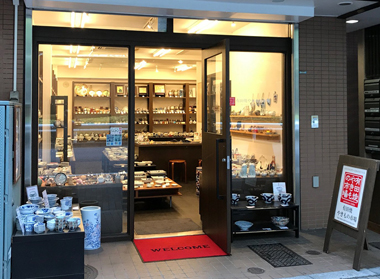 |
||||||||||||
|
||||||||||||








